tire pressure MERCEDES-BENZ C-Class COUPE 2013 CL204 Owner's Manual
[x] Cancel search | Manufacturer: MERCEDES-BENZ, Model Year: 2013, Model line: C-Class COUPE, Model: MERCEDES-BENZ C-Class COUPE 2013 CL204Pages: 350, PDF Size: 4.81 MB
Page 19 of 350

Technical data
Capacities ...................................... 337
Emergency spare wheel .................333
Information .................................... 336
Tires/wheels ................................. 328
Vehicle data ................................... 344
TELEAID
Call priority .................................... 261
Downloading destinations
(COMAND) ..................................... 261
Downloading route s....................... 264
Emergency call .............................. 258
Geo fencing ................................... 264
Important safety notes ..................257
Locating astolen vehicl e............... 263
MB info call button ........................260
Remote vehicle locking ..................262
Roadside Assistance button ..........260
Search &Send ............................... 262
Self-test ......................................... 258
Speed alert .................................... 264
System .......................................... 258
Triggering the vehicle alarm ........... 265
Vehicle remote malfunction
diagnosi s....................................... 263
Vehicle remote unlocking ..............262
Telephone
Accepting acall............................. 197
Display message ............................ 232
Menu (on-board computer) ............197
Number from the phone book ....... .198
Redialing ........................................ 198
Rejecting/ending acall................. 197
Temperature
Coolant .......................................... 190
Coolant (on-board computer) ......... 204
Engine oil (on-board computer) ...... 204
Outside temperature ..................... .191
Setting (climate control) ................126
Theft deterrent systems
ATA (Anti-Theft Alarm system) .........70
Immobilize r...................................... 69
Through-loading feature ...................250
Time see separate operating instructions
Timing (RACETIMER) .........................205
Tire pressure Calling up (on-board computer) .....308 Checking manually
........................307
Display message ............................ 228
Maximum ....................................... 306
Notes ............................................. 305
Pressure loss warning ....................307
Recommended ............................... 303
see Tire pressure
Tire pressure loss warning
system
Important safety notes ..................307
Restarting ...................................... 308
Tire pressure monitoring system
Checking the tire pressure
electronically ................................. 310
Function/notes ............................. 308
Restarting ...................................... 310
Warning lamp ................................. 246
Warning message .......................... 310
Tires
Aspect ratio (definition) .................323
Average weight of the vehicle
occupants (definition) ....................321
Bar (definition) ............................... 321
Changing awheel .......................... 324
Characteristics .............................. 321
Checking ........................................ 301
Definition of terms .........................321
Directio nofrotation ...................... 324
Display message ............................ 228
Distributio nofthe vehicle
occupants (definition) ....................323
DOT, Tire Identification Number
(TIN) .............................................. .320
DOT (Department of
Transportation) (definition) ............321
GAWR (Gross Axle Weight Rating)
(definition) ..................................... 322
GVW (Gross Vehicle Weight)
(definition) ..................................... 322
GVWR (Gross Vehicle Weight
Rating) (definition) .........................322
Important safety notes ..................300
Increased vehicle weight due to
optional equipment (definition) ......321
Kilopascal (kPa) (definition) ...........322
Labeling (overview )........................ 317
Load bearing index (definition) ......323
Load index ..................................... 320 Index
17
Page 20 of 350
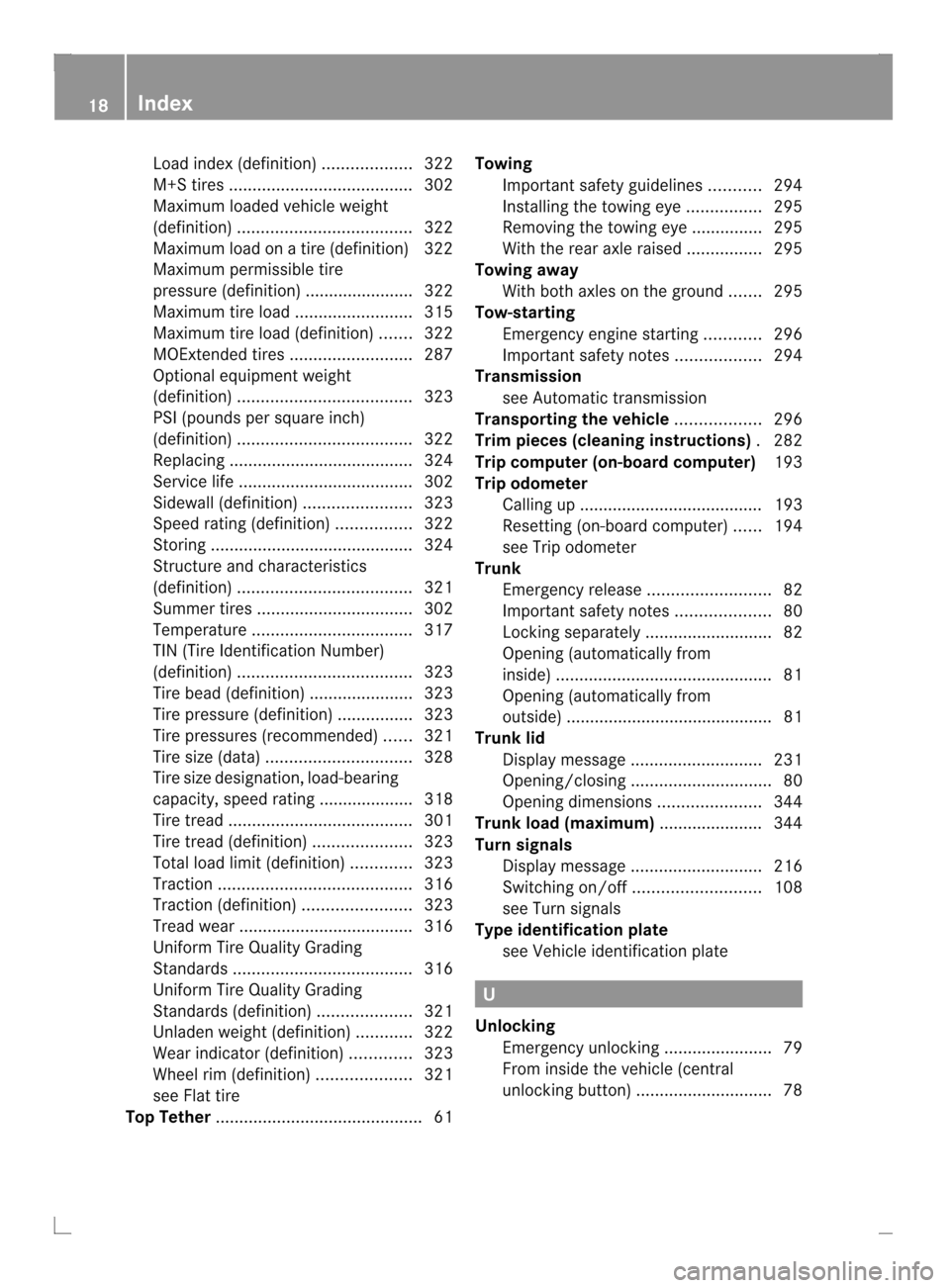
Load index (definition)
...................322
M+S tires ....................................... 302
Maximum loaded vehicle weight
(definition) ..................................... 322
Maximum load on a tire (definition) 322
Maximum permissible tire
pressure (definition) ....................... 322
Maximum tire loa d......................... 315
Maximum tire load (definition) .......322
MOExtended tires ..........................287
Optional equipment weight
(definition) ..................................... 323
PSI (pounds per square inch)
(definition) ..................................... 322
Replacing ....................................... 324
Service life ..................................... 302
Sidewall (definition) .......................323
Speed rating (definition) ................322
Storing ........................................... 324
Structure and characteristics
(definition) ..................................... 321
Summer tires ................................. 302
Temperature .................................. 317
TIN (Tire Identification Number)
(definition) ..................................... 323
Tire bea d(definition) ...................... 323
Tire pressure (definition) ................323
Tire pressures (recommended )...... 321
Tire size (data) ............................... 328
Tire size designation, load-bearing
capacity, speed rating .................... 318
Tire tread ....................................... 301
Tire tread (definition) .....................323
Total load limit (definition) .............323
Traction ......................................... 316
Traction (definition) .......................323
Trea dwear ..................................... 316
Uniform Tire Quality Grading
Standard s...................................... 316
Uniform Tire Quality Grading
Standard s(definition) .................... 321
Unladen weight (definition) ............322
Wea rindicato r(definition) .............323
Whee lrim (definition ).................... 321
see Flat tire
Top Tether ............................................ 61Towing
Important safety guidelines ...........294
Installing the towing eye ................295
Removing the towing eye. ..............295
With the rear axle raised ................295
Towing away
With both axles on the ground .......295
Tow-starting
Emergency engine starting ............296
Important safety notes ..................294
Transmission
see Automatic transmission
Transporting the vehicle ..................296
Trim pieces (cleaning instructions) .282
Trip computer (on-board computer) 193
Trip odometer Calling up ....................................... 193
Resetting (on-board computer) ......194
see Trip odometer
Trunk
Emergency release ..........................82
Important safety notes ....................80
Locking separatel y........................... 82
Opening (automatically from
inside) .............................................. 81
Opening (automatically from
outside) ............................................ 81
Trunk lid
Display message ............................ 231
Opening/closing .............................. 80
Opening dimensions ......................344
Trunk load (maximum) ......................344
Turn signals Display message ............................ 216
Switching on/off ........................... 108
see Turn signals
Type identification plate
see Vehicle identification plate U
Unlocking Emergency unlocking .......................79
From inside the vehicle (central
unlocking button) ............................. 7818
Index
Page 21 of 350

V
Vanity mirror (in the sun visor) ........ 254
Vehicle Data acquisition ............................... 26
Display message ............................ 230
Emergency locking ........................... 79
Emergency unlocking .......................79
Equipment ....................................... 22
Individua lsettings .......................... 200
Limited Warranty ............................. 26
Loading .......................................... 311
Locking (in an emergency) ...............79
Locking (SmartKey) .......................... 72
Lowering ........................................ 328
Maintenance .................................... 23
Parking for a long period ................ 152
Pulling away ................................... 136
Raising ........................................... 325
Reporting problems .........................26
Securing from rolling away ............325
Towing away .................................. 294
Transporting .................................. 296
Unlocking (in an emergency) ...........79
Unlocking (SmartKey) ......................72
Vehicle data ................................... 344
Vehicle data ....................................... 344
Vehicle dimensions ...........................344
Vehicle emergency locking ................79
Vehicle identification number see VIN
Vehicle identification plate ..............336
Vehicle tool kit .................................. 286
Video (DVD) ........................................ 197
VIN ...................................................... 336W
Warning and indicator lamps ABS ................................................ 236
Brakes ........................................... 236
Check Engine ................................. 242
Coolant .......................................... 243
Distance warning ........................... 245
DISTRONI CPLUS ........................... 245
ESP ®
.............................................. 238
ESP ®
OFF ....................................... 239
Fuel tank ........................................ 242 Overview
.......................................... 32
PASSENGER AIR BAG OFF
indicator lamp .................................. 46
Reserve fuel ................................... 242
Seat bel t........................................ 234
SPORT handling mode ...................239
SRS ................................................ 241
Tire pressure monitor ....................246
Warranty ............................................ 336
Washer fluid Display message ............................ 232
Wheel bol ttightening torque ...........328
Wheel chock ...................................... 325
Wheels Changing awheel .......................... 324
Checking ........................................ 301
Cleaning ......................................... 279
Cleaning (warning) .........................324
Emergency spare wheel .................331
Important safety notes ..................300
Interchanging/changing ................324
Mounting anew wheel ................... 327
Mounting awheel .......................... 324
Removing awheel .......................... 327
Storing ........................................... 324
Tightening torque ........................... 328
Whee lsize/tir esize ....................... 328
Window curtain air bag
Display message ............................ 213
Operation ........................................ .46
Windows
see Side windows
Windshield
Defrosting ...................................... 127
see Windshield
Windshiel dwasher fluid
see Windshield washer system
Windshield washer system ..............277
Notes ............................................. 342
Windshiel dwipers
Problem (malfunction) ...................119
Replacing the wiper blades ............117
Switching on/off ........................... 116
Winte rdriving
Important safety note s.................. 302
Slippery road surfaces ...................157
Snow chains .................................. 303 Index
19
Page 23 of 350
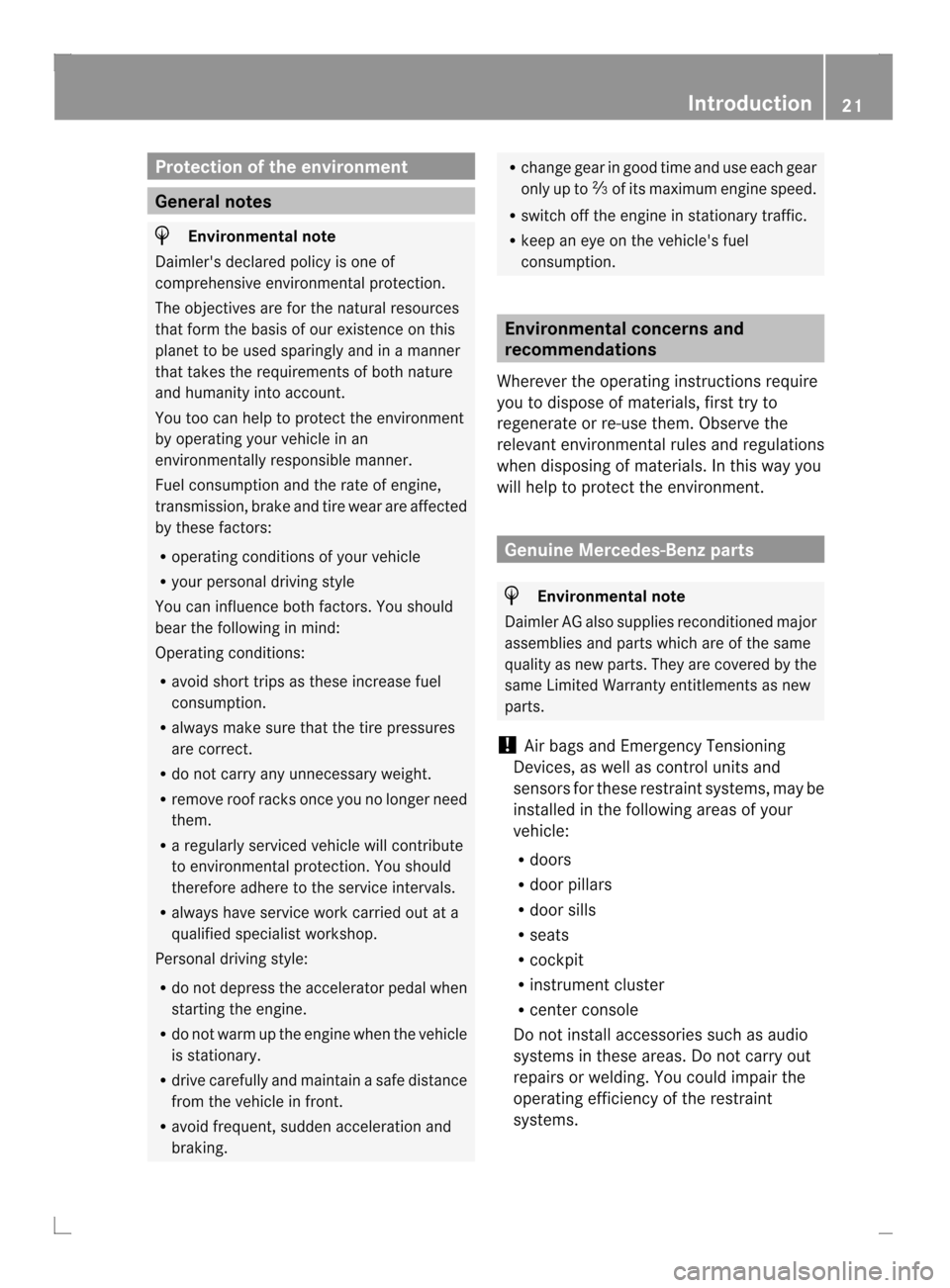
Protection of the environment
General notes
H
Environmental note
Daimler's declared policy is one of
comprehensive environmental protection.
The objectives are for the natural resources
that form the basis of our existence on this
planet to be used sparingly and in a manner
that takes the requirements of both nature
and humanity into account.
You too can help to protect the environment
by operating your vehicle in an
environmentally responsible manner.
Fuel consumption and the rate of engine,
transmission, brake and tire wear are affected
by these factors:
R operating conditions of your vehicle
R your personal driving style
You can influence both factors. You should
bear the following in mind:
Operating conditions:
R avoid short trips as these increase fuel
consumption.
R always make sure that the tire pressures
are correct.
R do not carry any unnecessary weight.
R remove roof racks once you no longer need
them.
R a regularly serviced vehicle will contribute
to environmental protection. You should
therefore adhere to the service intervals.
R always have service work carried out at a
qualified specialist workshop.
Personal driving style:
R do not depress the accelerator pedal when
starting the engine.
R do not warm up the engine when the vehicle
is stationary.
R drive carefully and maintain a safe distance
from the vehicle in front.
R avoid frequent, sudden acceleration and
braking. R
change gear in good time and use each gear
only up to 0001of its maximum engine speed.
R switch off the engine in stationary traffic.
R keep an eye on the vehicle's fuel
consumption. Environmental concerns and
recommendations
Wherever the operating instructions require
you to dispose of materials, first try to
regenerate or re-use them. Observe the
relevant environmental rules and regulations
when disposing of materials. In this way you
will help to protect the environment. Genuine Mercedes-Benz parts
H
Environmental note
Daimler AG also supplies reconditioned major
assemblies and parts which are of the same
quality as new parts. They are covered by the
same Limited Warranty entitlements as new
parts.
! Air bags and Emergency Tensioning
Devices, as well as control units and
sensors for these restraint systems, may be
installed in the following areas of your
vehicle:
R doors
R door pillars
R door sills
R seats
R cockpit
R instrument cluster
R center console
Do not install accessories such as audio
systems in these areas. Do not carry out
repairs or welding. You could impair the
operating efficiency of the restraint
systems. Introduction
21 Z
Page 34 of 350
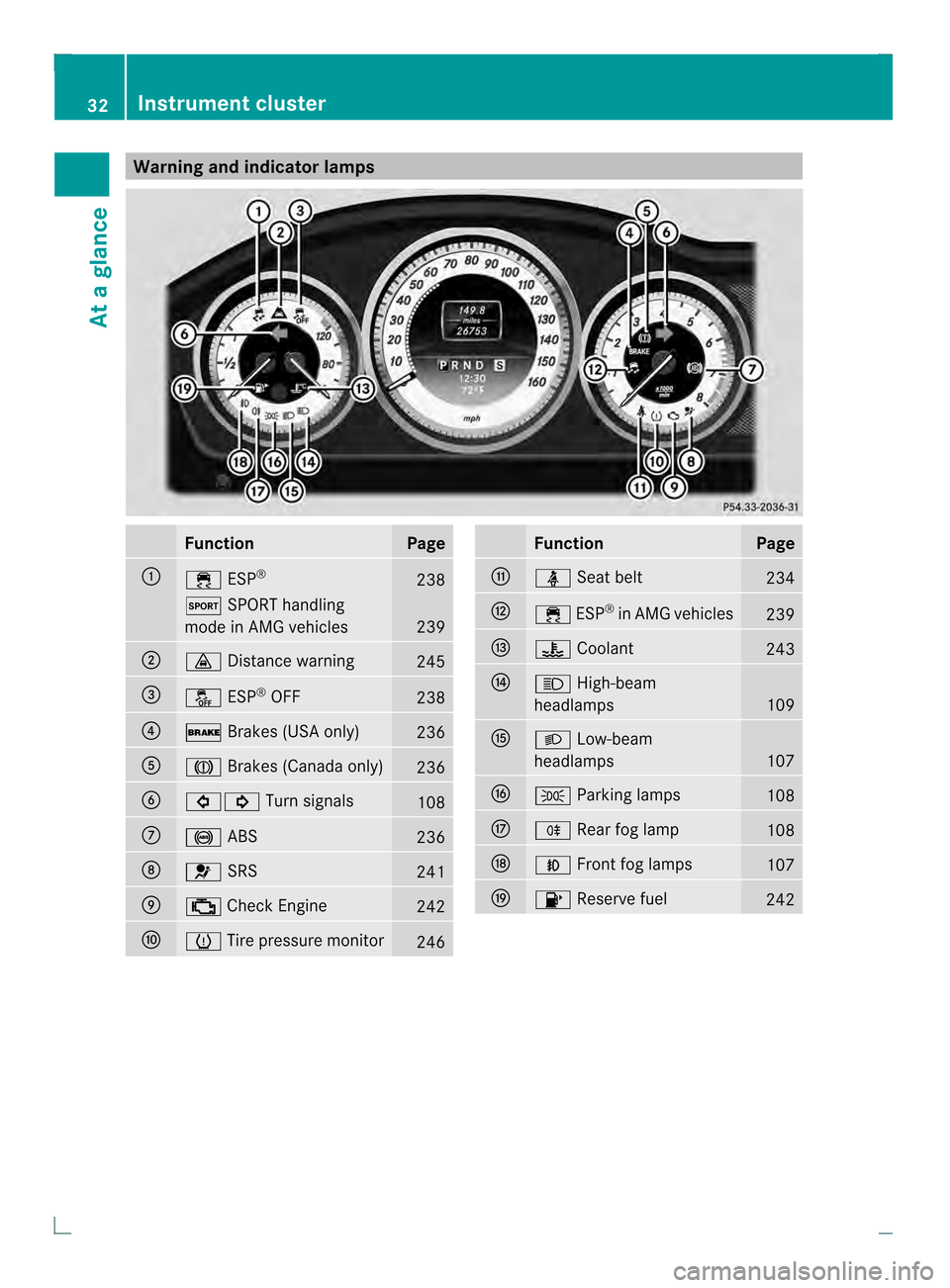
Warning and indicator lamps
Function Page
0002
000D
ESP® 238
0003
SPORT handling
mode in AMG vehicles 239
0003
000B
Distance warning 245
0022
0015
ESP®
OFF 238
0021
000C
Brakes (USA only) 236
001F
0006
Brakes (Canada only) 236
0020
00070006
Turn signals 108
0012
0018
ABS 236
0013
001E
SRS 241
0014
000C
Check Engine 242
0015
0012
Tire pressure monitor 246 Function Page
0016
0012
Seat belt 234
0018
000D
ESP®
in AMG vehicles 239
0019
000A
Coolant 243
001A
000A
High-beam
headlamps 109
001B
000B
Low-beam
headlamps 107
001D
0014
Parking lamps 108
001E
000E
Rearfog lamp 108
0023
000C
Front fog lamps 107
0024
000E
Reserve fuel 24232
Instrument clusterAt a glance
Page 66 of 350

At
as pee dless than 20 mp h(30 km/h) : if
you depress the brake pedal, BASP LUS is
activated. Braking is performed as late as
possible.
At a speed greater than 20 mph
(30 km/h):ify ou depress the brake pedal
sharply, BAS PLUS automatically raises the
brake pressure to a value adapted to the
traffic situation.
X Keep the brake pedal depressed until the
emergency braking situation is over.
ABS prevents the wheels from locking.
BAS PLUS is deactivated and the brakes
function as usual, if:
R you release the brake pedal.
R there is no longer any danger of a rear-end
collision.
R no obstacle is detected in front of your
vehicle. G
WARNING
BAS PLUS cannot always clearly identify
objects and complex traffic situations. BAS
PLUS cannot intervene in these cases. There
is a risk of an accident.
Always pay careful attention to the traffic
situation and be ready to brake.
In particular, the detection of obstacles can
be impaired if there is:
R dirt on the sensors or anything else
covering the sensors
R snow or heavy rain
R interference by other radar sources
R there are strong radar reflections, for
example in parking garages
R a narrow vehicle traveling in front, e.g. a
motorbike
R a vehicle traveling in front on a different line
relative to the center of your vehicle G
WARNING
BAS PLUS does not react:
R to people or animals
R to oncoming vehicles
R to crossing traffic
R when cornering
As aresult, BAS PLUS may not intervene in all
critical situations. There is a risk of an
accident.
Always pay careful attention to the traffic
situation and be ready to brake.
Following damage to the fron tend of the
vehicle, have the configuratio nand operation
of the rada rsensors checked at a qualified
specialist workshop. This also applies to
collisions at low speeds where there is no
visible damage to the fron tofthe vehicle. ESP
®
(Electronic Stability Program)
General notes i
Observe the "Important safety notes"
section (Y page 62).
ESP ®
monitors driving stability and traction,
i.e. power transmission between the tires and
the road surface.
If ESP ®
detects that the vehicle is deviating
from the direction desired by the driver, one
or more wheels are braked to stabilize the
vehicle. The engine output is also modified to
keep the vehicle on the desired course within
physical limits. ESP ®
assists the driver when
pulling away on wet or slippery roads. ESP ®
can also stabilize the vehicle during braking.
ETS/4ETS (Electronic Traction System) i
Observe the "Important safety notes"
section (Y page 62).
ETS/4ETS traction control is part of ESP ®
.
Traction control brakes the drive wheels
individually if they spin. This enables you to
pull away and accelerate on slippery surfaces, 64
Driving safety systemsSafety
Page 150 of 350

You must make sure that fuel does not come
into contact with your skin, eyes or clothing
and that it is not swallowed. Do not inhale fuel
vapors .Keep fuel away from children.
If you or others come into contact with fuel,
observe the following:
R Wash away fuel from skin immediately
using soap and water.
R If fuel comes into contact with your eyes,
immediately rinse them thoroughly with
clean water. Seek medical assistance
without delay.
R If fuel is swallowed, seek medical
assistance without delay. Do not induce
vomiting.
R Immediately change out of clothing which
has come into contact with fuel. G
WARNING
Electrostatic buildup can create sparks and
ignite fuel vapors. There is a risk of fire and
explosion.
Always touch the vehicle body before opening
the fuel filler flap or touching the fuel pump
nozzle. Any existing electrostatic buildup is
thereby discharged.
! Overfilling the fuel tank could damage the
fuel system.
! Take care not to spill any fuel on painted
surfaces. You could otherwise damage the
paintwork.
! Use a filter when refueling from a fuel can.
Otherwise, the fuel lines and/or injection
system could be blocked by particles from
the fuel can.
Do not get into the vehicle again during the
refueling process .Otherwise, electrostatic
charge could build up again.
If you overfill the fuel tank, fuel could spray
ou tw hen the fuel pump nozzle is removed.
For further information on fuel and fuel quality
(Y page 337). Refueling
Opening/closing the fuel filler flap 0002
To open the fuel filler flap
0003 To insert the fuel filler cap
0022 Tire pressure table
0021 Fuel type to be used
The fuel filler flap is unlocked or locked
automatically when you open or close the
vehicle with the SmartKey or with KEYLESS-
GO.
The position of the fuel filler cap is displayed
000E in the instrument cluster. The arrow
next to the filling pump indicates the side of
the vehicle.
To open X
Switch the engine off.
X Remove the SmartKey from the ignition
lock.
X KEYLESS-GO: open the driver’s door.
This corresponds to key position 0: "key
removed".
The driver’s door can be closed again.
X Press the fuel filler flap in the direction of
arrow 0002.
The fuel filler flap opens slightly.
X Open the fuel filler flap fully.
X Turn the fuel filler flap counter-clockwise
and remove it.
X Insert the fuel filler cap into the holder
bracket on the inside of filler flap 0003.148
RefuelingDriving and parking
Page 154 of 350
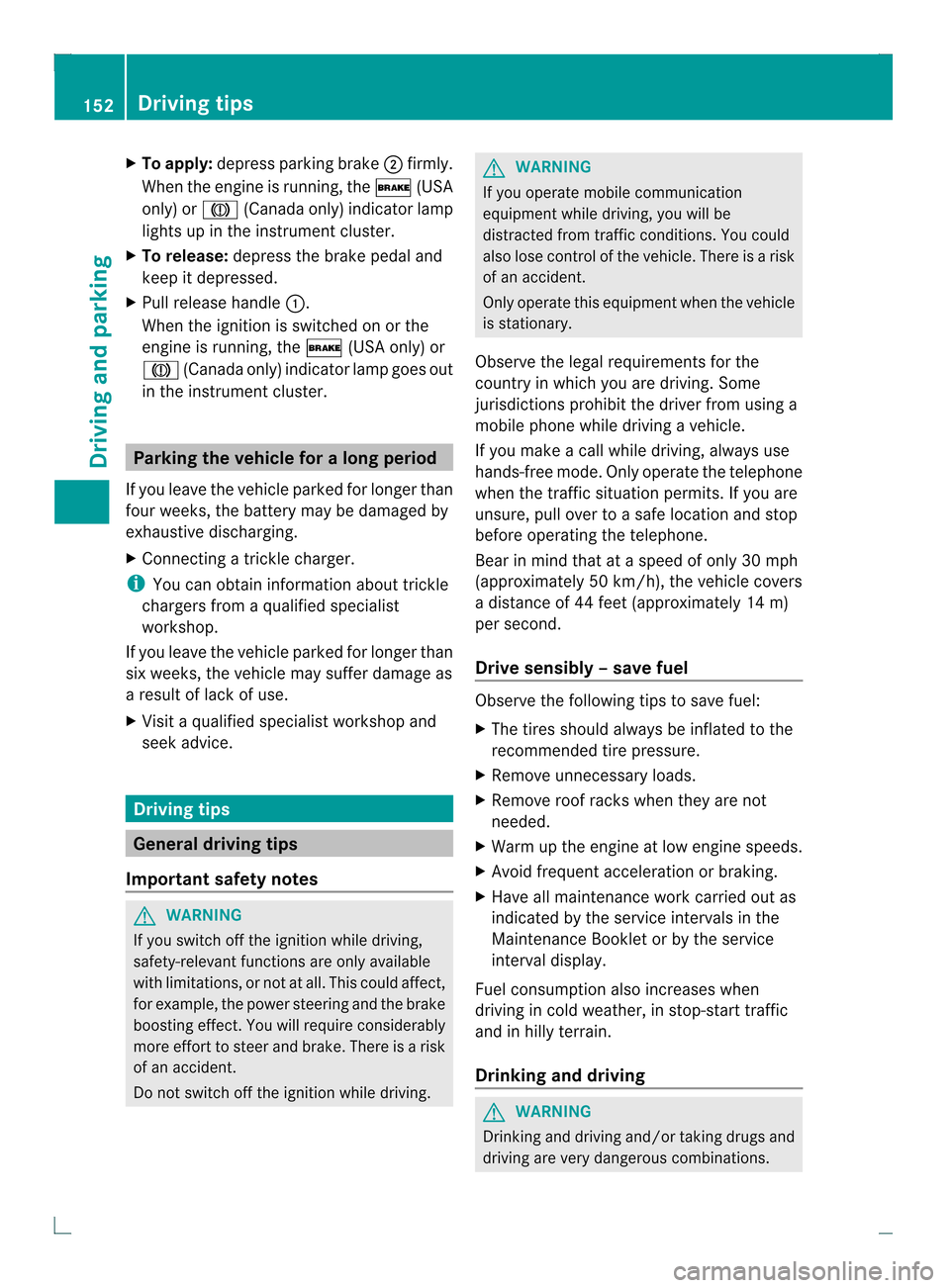
X
To apply: depress parking brake 0003firmly.
Whe nthe engine is running, the 000C(USA
only) or 0006(Canada only) indicator lamp
lights up in the instrumentc luster.
X To release: depress the brake pedal and
keep it depressed.
X Pull release handle 0002.
When the ignition is switched on or the
engine is running, the 000C(USA only) or
0006 (Canada only) indicator lamp goes out
in the instrument cluster. Parking the vehicle for
along period
If you leave the vehicle parked for longer than
four weeks, the battery may be damaged by
exhaustive discharging.
X Connecting a trickle charger.
i You can obtain information about trickle
chargers from a qualified specialist
workshop.
If you leave the vehicle parked for longer than
six weeks, the vehicle may suffer damage as
a result of lack of use.
X Visit a qualified specialist workshop and
seek advice. Driving tips
General driving tips
Important safety notes G
WARNING
If you switch off the ignitio nwhile driving,
safety-relevant functions are only available
with limitations, or not at all. This could affect,
for example, the power steering and the brake
boosting effect.Y ou will require considerably
more effort to steer and brake. There is a risk
of an accident.
Do not switch off the ignition while driving. G
WARNING
If you operate mobile communication
equipment while driving, you will be
distracted from traffic conditions. You could
also lose control of the vehicle. There is a risk
of an accident.
Only operate this equipment when the vehicle
is stationary.
Observe the legal requirements for the
country in which you are driving. Some
jurisdictions prohibit the driver from using a
mobile phone while driving a vehicle.
If you make a call while driving, always use
hands-free mode. Only operate the telephone
when the traffic situation permits. If you are
unsure, pull over to a safe location and stop
before operating the telephone.
Bear in mind that at a speed of only 30 mph
(approximately 50 km/h), the vehicle covers
a distance of 44 feet (approximately 14 m)
per second.
Drive sensibly –save fuel Observe the following tips to save fuel:
X
The tires should always be inflated to the
recommended tire pressure.
X Remove unnecessary loads.
X Remove roof racks whe nthey are not
needed.
X Warm up the engine at low engine speeds.
X Avoid frequent acceleration or braking.
X Have all maintenance work carried out as
indicated by the service intervals in the
Maintenance Booklet or by the service
interval display.
Fuel consumption also increases when
driving in cold weather, in stop-start traffic
and in hilly terrain.
Drinking and driving G
WARNING
Drinking and driving and/or taking drugs and
driving are very dangerous combinations. 152
Driving tipsDriving and parking
Page 155 of 350
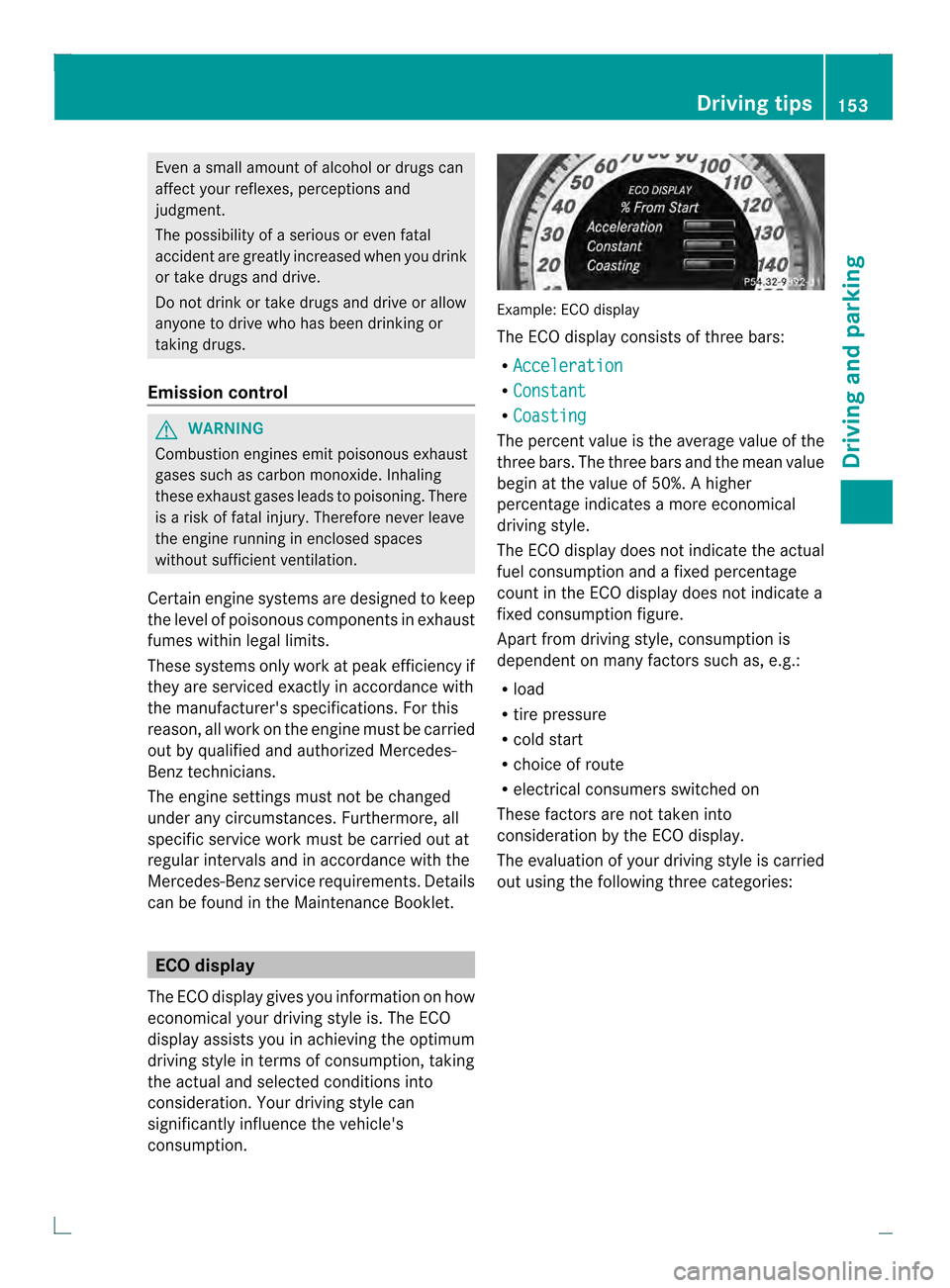
Even a small amount of alcohol or drugs can
affect your reflexes, perceptions and
judgment.
The possibility of a serious or eve nfatal
acciden tare greatly increased when you drink
or take drugs and drive.
Do not drink or take drugs and drive or allow
anyone to drive who has been drinking or
taking drugs.
Emission control G
WARNING
Combustion engines emit poisonous exhaust
gases such as carbon monoxide. Inhaling
these exhaust gases leads to poisoning. There
is a risk of fatal injury. Therefore never leave
the engine running in enclosed spaces
withou tsufficient ventilation.
Certain engine systems are designed to keep
the level of poisonous components in exhaust
fumes within legal limits.
These systems only work at peak efficiency if
they are serviced exactly in accordance with
the manufacturer's specifications. For this
reason, all work on th eengine must be carried
ou tb y qualified and authorized Mercedes-
Benz technicians.
The engine settings mus tnot be changed
under any circumstances. Furthermore, all
specific service work must be carried out at
regular intervals and in accordance with the
Mercedes-Benz service requirements. Details
can be found in the Maintenance Booklet. ECO display
The ECO display gives you information on how
economical your driving style is. The ECO
display assists you in achieving the optimum
driving style in terms of consumption, taking
the actual and selected conditions into
consideration. Your driving style can
significantly influence the vehicle's
consumption. Example: ECO display
The ECO display consists of three bars:
R
Acceleration R
Constant R
Coasting The percent value is the average value of the
three bars. The three bars and the mean value
begin at the value of 50%.
Ahigher
percentage indicates a mor eeconomical
driving style.
The ECO display does not indicate the actual
fuel consumption and a fixed percentage
count in the ECO display does not indicate a
fixed consumption figure.
Apart from driving style, consumption is
dependent on many factors such as, e.g.:
R load
R tire pressure
R cold start
R choice of route
R electrical consumers switched on
These factors are not taken into
consideration by the ECO display.
The evaluation of your driving style is carried
ou tu sing the following three categories: Driving tips
153Driving and parking Z
Page 177 of 350
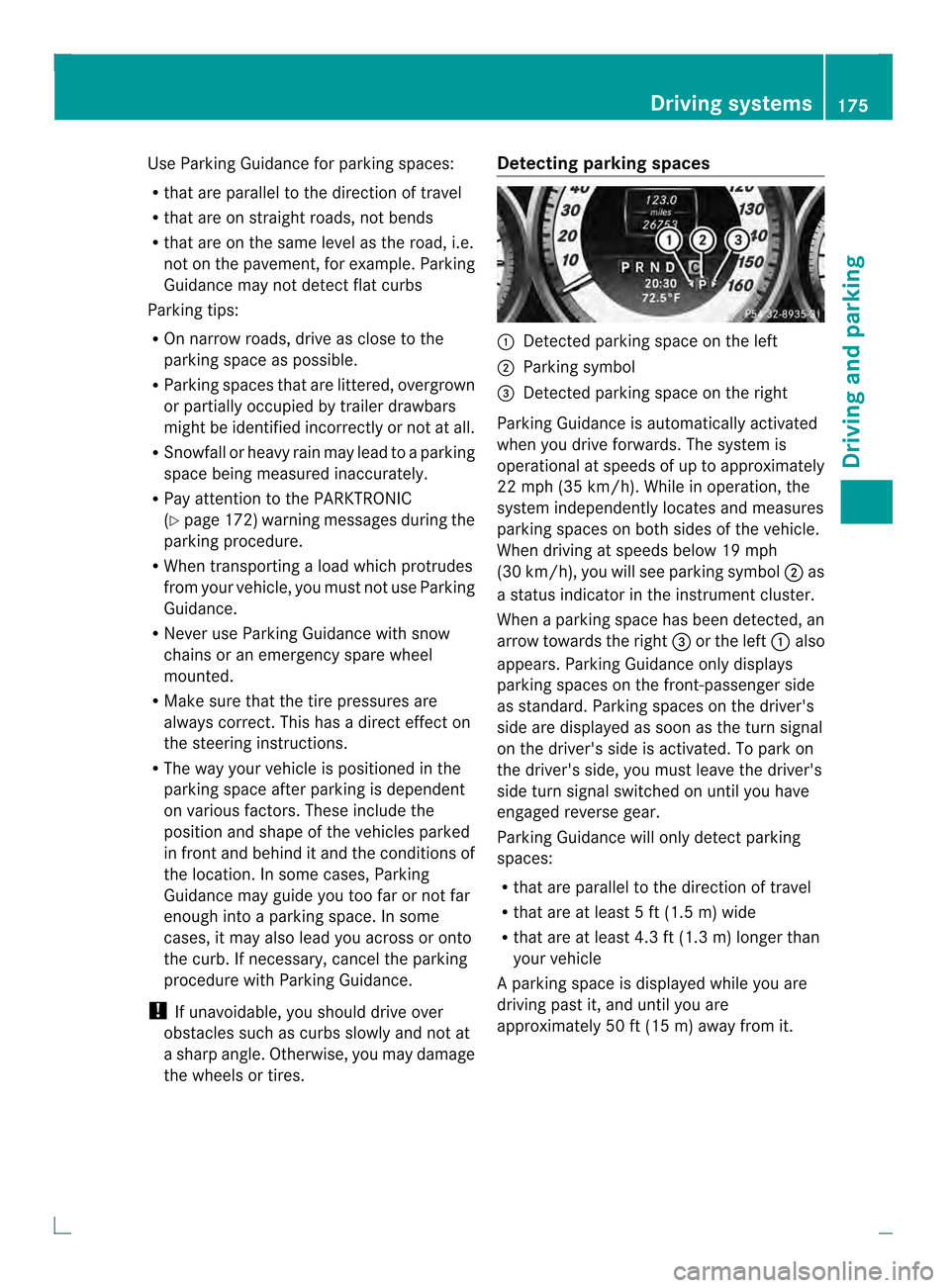
Use Parking Guidance for parking spaces:
R that are parallel to the direction of travel
R that are on straight roads, not bends
R that are on the same level as the road, i.e.
not on the pavement, for example. Parking
Guidance may not detect flat curbs
Parking tips:
R On narrow roads, drive as close to the
parking space as possible.
R Parking spaces that are littered, overgrown
or partially occupied by trailer drawbars
might be identified incorrectly or not at all.
R Snowfall or heavy rain may lead to a parking
space being measured inaccurately.
R Pay attention to the PARKTRONIC
(Y page 172) warning messages during the
parking procedure.
R When transporting a load which protrudes
from your vehicle, you must not use Parking
Guidance.
R Never use Parking Guidance with snow
chains or an emergency spare wheel
mounted.
R Make sure that the tire pressures are
always correct.T his hasadirec teffect on
the steering instructions.
R The way you rvehicle is positioned in the
parking space after parkin gis dependent
on various factors. These include the
position and shape of the vehicles parked
in front and behind it and the conditions of
the location. In some cases, Parking
Guidance may guide you too far or not far
enough into a parking space. In some
cases, it may also lead you across or onto
the curb. If necessary, cancel the parking
procedure with Parking Guidance.
! If unavoidable, you should drive over
obstacles such as curbs slowly and not at
a sharp angle. Otherwise, you may damage
the wheels or tires. Detecting parking spaces 0002
Detected parking space on the left
0003 Parking symbol
0022 Detected parking space on the right
Parking Guidance is automatically activated
when you drive forwards. The system is
operational at speeds of up to approximately
22 mph (35 km/h). While in operation, the
system independently locates and measures
parking spaces on both sides of the vehicle.
When driving at speeds below 19 mph
(30 km/h), you will see parking symbol 0003as
a status indicator in the instrument cluster.
When a parking space has been detected, an
arrow towards the right 0022or the left 0002also
appears. Parking Guidance only displays
parking spaces on the front-passenger side
as standard. Parking spaces on the driver's
side are displayed as soon as the turn signal
on the driver's side is activated. To park on
the driver's side, you must leave the driver's
side turn signal switched on until you have
engaged reverse gear.
Parking Guidance will only detect parking
spaces:
R that are parallel to the direction of travel
R that are at least 5 ft (1.5 m) wide
R that are at least 4.3 ft (1.3 m) longer than
your vehicle
Ap arking space is displayed while you are
driving past it, and until you are
approximately 50 ft (15 m) away from it. Driving systems
175Driving and parking Z